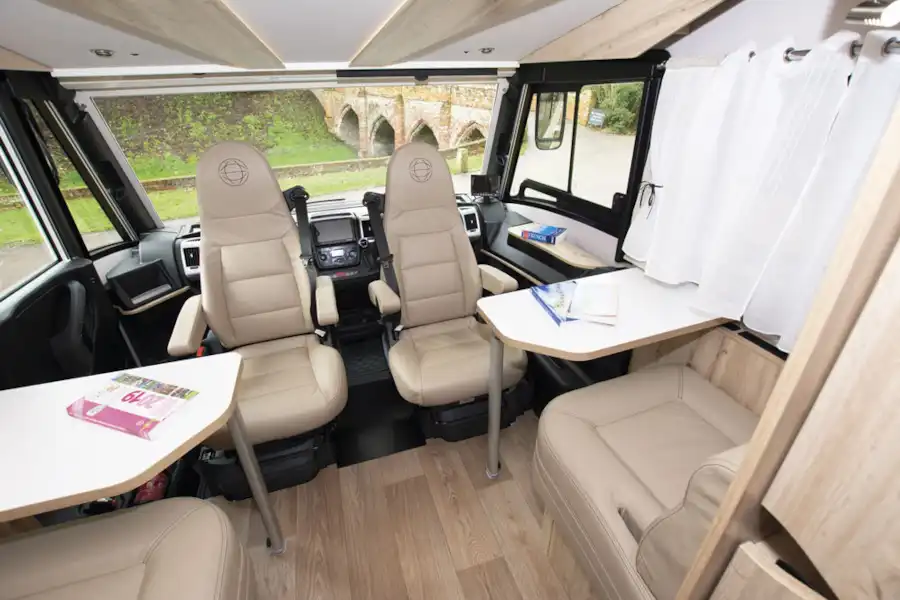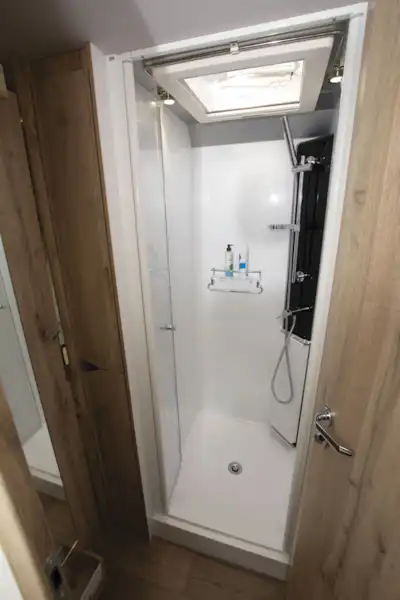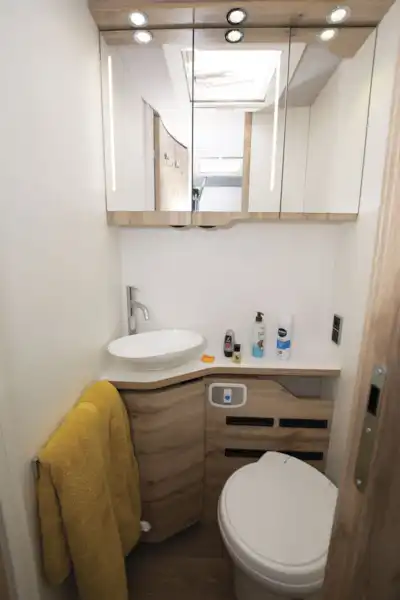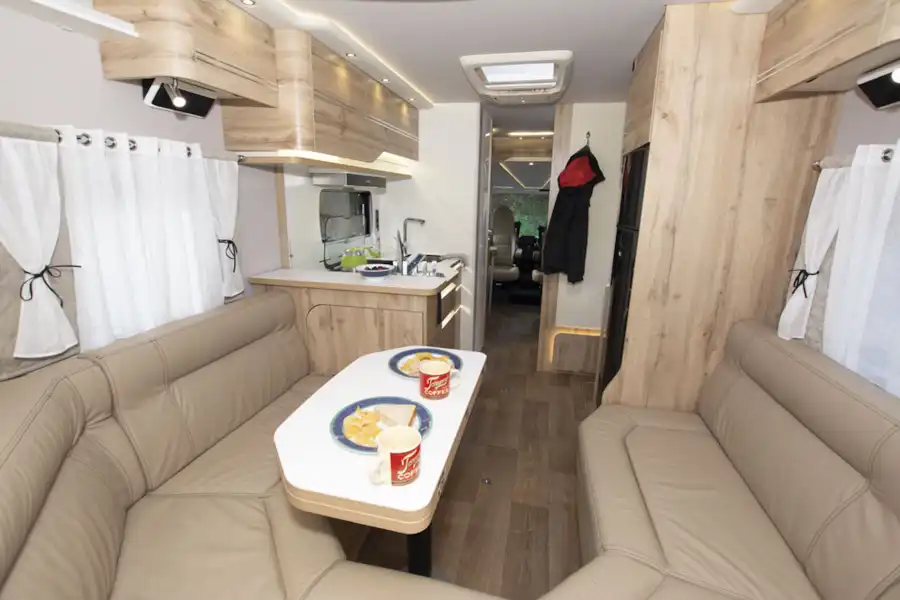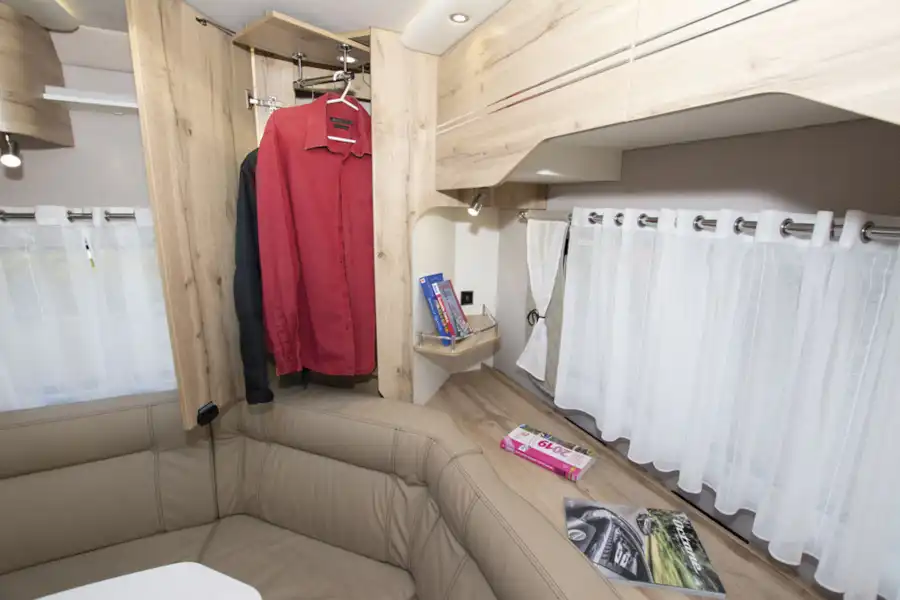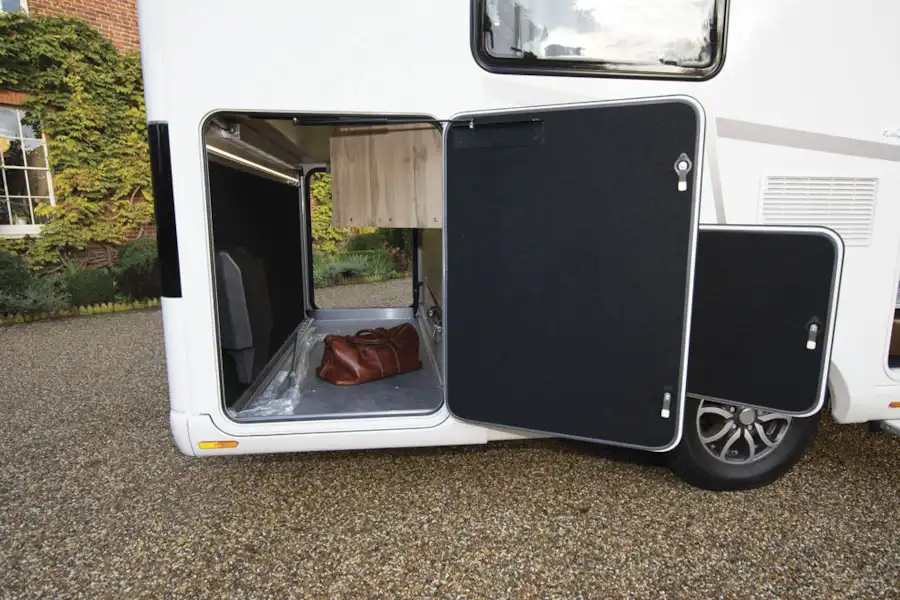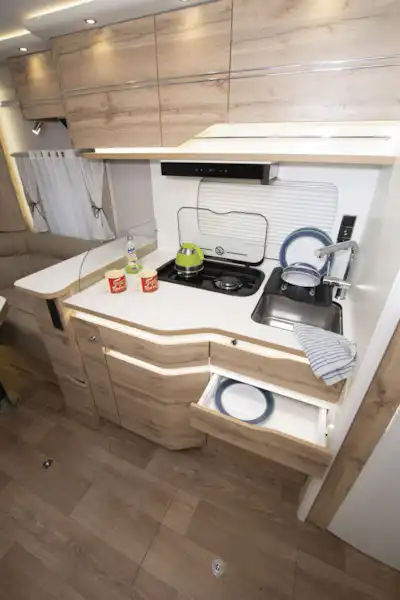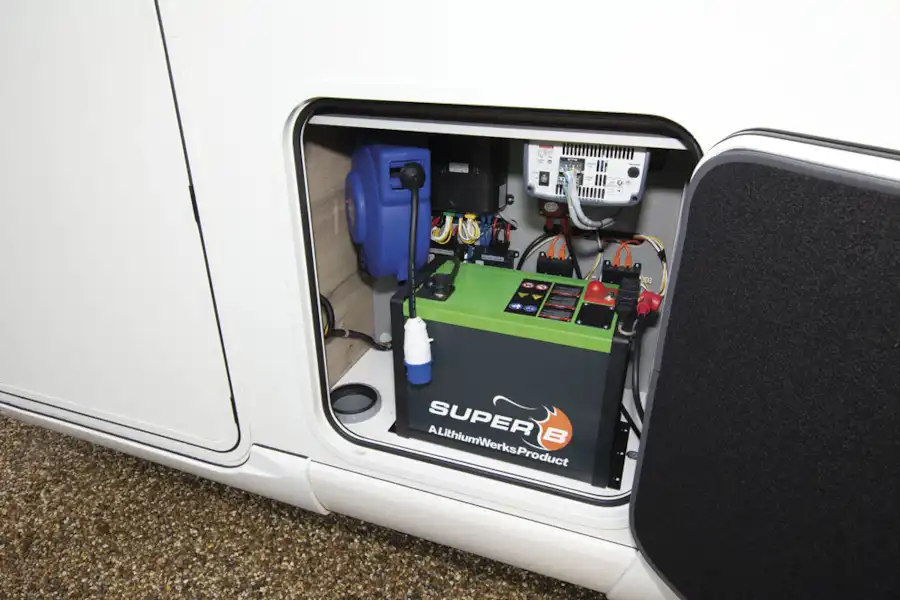Key Features
| Model Year | 2020 |
| Class | A-Class |
| Base Vehicle | Fiat Ducato |
| Price From (£) | 100088 excl VED |
| Engine Size | 2.3TD |
| Maximum Weight (kg) | 4,500 |
| Berths | 2 |
| Main Layout | Rear Lounge |
At a glance
Full review
Words by Peter Vaughan
If you’re looking at a top-end A-class motorhome, something beyond the more mass-produced marques, then all the options seem to be German. But, while British buyers may love their Audis and BMWs, when it comes to domestic matters and homeliness, Teutonic tastes can be a touch too austere. So, how about a little French chic instead?
Le Voyageur has been building luxury A-class motorhomes since 1981 and has been part of Groupe Pilote since 2000, but its vehicles are still less well-known in the UK than in their homeland. Pullingers Leisure Vehicles in Essex is doing its bit to change that, however, as one of four UK dealers (plus one in Ireland) that make up an expanded network, and 2020 could be the year to take notice of this Gallic brand as it launches a rear lounge layout.
The LV7.8LU motorhome sits in the Fiat-based Classic range (there are Iveco-based Signatures above and Liners at the top) and is at the larger end of that line-up, measuring 7.85m. It comes on a single-rear-axle Al-Ko chassis with a 4,500kg gross weight.
The styling is less boxy than most German A-classes, with a curvaceous nose that retains the Fiat Ducato headlights and has an overlapping domed roof to prevent water retention on top. Of course, there’s a double floor (26cm deep), too, while the bodywork has a polyester outer skin and aluminium sheet internally for better heat diffusion.
Driving Le Voyageur Classic LV7.8LU motorhome
The standard power unit is 140bhp with a manual gearbox, but a motorhome of this calibre deserves the best and so our test motorhome came with the pricey combo of the 178bhp Euro 6d engine (still a 2.3-litre) and the new nine-speed automatic gearbox.
To say this torque converter transmission is better than the old robotised Comfort-Matic is like saying that a Euromillions lottery win is better than finding 5p down the back of the sofa. At last, here is a Fiat auto’ that drives as smoothly as pouring melted caramel. And you can switch between modes – Eco (if you’re feeling a bit slothful), Normal (probably just right for 90% of the time) and Power (which might suit alpine climbs) – or change manually.
Our test drive wasn’t long – or alpine, sadly – but you don’t need to go far to appreciate this gearbox, nor the grunty delivery of this top-spec engine, which felt a good deal smoother than previous generations of Fiat Multijet motors.
On the road, the Al-Ko chassis provided a very firm ride (but few rattles from the interior), combined with a very surefooted feel, despite wintry weather conditions that were far from ideal.
Visibility is good, too, aided by a screen (separate to the 9in idMedia touchscreen radio unit, for which sat-nav is an extra-cost add-on) that offers views from cameras in the bus-style mirrors as well as on the back wall. It was disappointing, though, to discover that the windscreen wipers still adopt a left-hand drive layout on a RHD ’van.
There’s now a choice of premium-spec rear lounge A-classes from the likes of Carthago, Dethleffs and Frankia but none is quite like this. For a start, the Le Voyageur has two seating areas and four travel seats.
Up front, it’s not the half-dinette that you might expect but a pair of individual forward-facing seats that join the swivel Aguti captain’s chairs in the cab to form a roomy four-person lounge. Each of the mini-dinettes has its own table which can be stored away safely for travel.
It’s here, too, that you first start to notice the top-notch detailing in this Le Voyageur – the stylish net curtains and voiles, the twin USBs and mains sockets by each table, the vast array of lighting (much of it dimmable), the soft, padded trim on walls and ceiling and the superbly finished, double-stitched leather upholstery (a £2,784 option).
There’s the practical aspect of having two lounges, of course, which will really come into its own if you travel four-up, but the height of the rear pasenger seats does favour adults rather than kids (there’s good storage below with easy drop-front access).
Then, as you walk back through the vehicle, you notice another positive – the flat floor throughout (with a couple of storage hatches in the centre of the motorhome and servicing access to the water tanks beyond). There’s lots of use of white, in the kitchen area especially, and this pale Dune cabinetwork also helps with the bright, spacious feel.
There are backlit details everywhere, too, from kitchen drawer fronts to ceiling panels and around the coat hanging area in the doorway. And, even on the gloomiest winter day, with the nets drawn, the triple rear windows, large wind-up Heki sunroof and rooflight built into the Dometic habitation air-conditioning unit add up to plenty of natural light. You won’t feel claustrophobic in this motorhome.
The lounge in Le Voyageur Classic LV7.8LU motorhome
By now, though, you’ll have been drawn to the rear lounge. Someone at the Angers factory in the Loire Valley clearly has an eye for style, for, just like the front seating space, this is not your typical end lounge.
Built around an octagonal table that’s large enough for four hungry gastronomes, is a settee that follows that shape, creating a five-sided sofa that looks perfect for convivial evenings with friends or family.
It’s not a big lounge compared with, say, Carthago’s Liner-for-two but the area feels more spacious once the table has been folded in half. Importantly, there’s plenty of room for a couple to spread out and relax, while between the settee and rear window there’s a usefully large shelved area with double USBs on either side. Corner wardrobes are incorporated here, too, and they automatically illuminate and, better still, pull your shirts and skirts towards you on extending hanging rails when you open the doors.
The pièce de résistance in the lounge, though, is the £4,500 TV Pack. As well as the 32in Teleco full HD screen, this includes an automatic 85cm satellite dish and decoder, wall-mounted Jehnert speakers and amplifier and, coolest of all, an electrically raising TV bracket that sees the telly appear – James Bond style – from the end of the galley.
The kitchen in Le Voyageur Classic LV7.8LU motorhome
Hailing from a nation famed for its food, it seems odd to find that a two-burner hob – albeit a stylish one with a glossy black base and unequal rings – is the only cooking kit. Maybe buyers will follow the Guide Michelin or Gault & Millau for restaurant dining, or barbecue outside, but buyers who like to cook should not stop reading. An oven is available either in the kitchen base unit or above the 160-litre two-door AES fridge/freezer, while a microwave is also offered, as is a three-ring hob.
You might also be tempted by the optional resin worktop, but this kitchen is not short of star quality as it is. The stylish cooker hood with clock may catch your eye first, but I also liked the generous worktop, the anti-drip swiveLling metal tap and the sink lid that reverses to become a plate drying rack, complete with drain to drip into the sink.
The storage impresses, too, with a vast array of slide-out sections, from a large cutlery drawer to a huge pull-out compartment including two bins and a rack for eight bottles.
There’s also a deep drawer for all your pans and a further slide-out rack for a quartet of wine bottles (very French), as well as one for tins, and most of these drawers are locked for travel by a single key (a buzzer sounds if you forget it and drive off). Motorhome kitchen storage has never been better planned.
Beds in Le Voyageur Classic LV7.8LU motorhome
The main bed is the manual drop-down one in the cab – a conventional transverse double with Bultex mattress and a shelf with more USBs, but no roof vent. We’d upgrade this to the Duo Bed (£2,001 extra) which lowers electrically before extending rearwards to create a 2m-long bed in which you can sleep lengthways (easier for access without disturbing your better half).
Closing the toilet door across the aisle separates the whole front bedroom area, but you can also deploy a slide-out division with full-length mirror to make a completely private ablutions space.
The plastic Thetford toilet might look a bit ordinary in this environment but the toilet area has backlit mirrors hiding plenty of practical storage (with lipped shelves to keep its contents in situ). Opposite, there’s a super-sized shower with sensible central drain, shelf for gels, rail for your flannel and (like the toilet area) a large roof vent above. In fact, the shower is another star feature of the LV7.8LU.
Then, alongside the shower, is a tall, slim unit with removable shelves that can act as a third mini-wardrobe.
In future, the rear lounge will also be fitted with a telescopic table leg to allow this area to convert into a second double bed, so this motorhome can be a full four-berth.
If you plan to use your Le Voyageur for family motorhoming then you shouldn’t be short of storage. The payload of 810kg sounds pretty substantial, too, until you learn that it allows for just 20 litres in the 200-litre fresh water tank while you drive and that the £24,625-worth of options fitted to this test vehicle also account for just over 200kg of payload. Still, 600kg should be enough, bearing in mind that the weighty awning and satellite dish are already allowed for.
Also, while the LV7.8LU has an unusually generous garage for a rear lounge model, there is some intrusion into this space from the settee above, so you won’t be loading a motorbike in here. You do, however, have a space that’s up to 1.19m high (across a minimum 43cm width), reducing to 74cm tall under the lounge seating. There are upper and lower tie-downs here, too, plus 12V and 230V sockets and a full-width LED strip light.
That’s not the only external storage, either. On the offside are gas (larger 13kg cylinders) and battery (upgraded to lithium as a pricey option here) compartments, as well as a hatch opening onto under-seat space in the front lounge and a full-width area in the double floor. That storage and access up front is mirrored on the nearside, where you’ll also find toilet and Alde heating servicing hatches, as well as an additional deep locker under the rear settee.
Also included alongside the Alde unit are a built-in fresh water hose on a reel, the waste water drain valve (in an inboard location where it won’t freeze) and a facility to top up fresh water when you can’t get close to a tap. Meanwhile, another practical (but optional) feature is found in the battery locker, where a mains lead is again mounted on a reel, ready for use – very neat.
There’s so much to admire here, and the build quality impressed throughout (except perhaps for the slide-out bedroom/bathroom division, which looked as if it might have suffered abuse at the show). And there are plenty more options to make this Le Voyageur even more luxurious – Al-Ko pneumatic suspension, cab double glazing, heated cab seats and a ceramic toilet, for example.
Expert motorhome advice to your door!
Why not subscribe to one of our fabulous magazines and get expert advice, travel ideas, technical help and all the latest news for your motorhome and your motorhome adventures!
Want to know more about MMM magazine?
Every month MMM has articles written by motorhomers who have been there and done it, from great UK and European (and further afield) tours, campsite reviews, owners' reports and DIY projects among other things. MMM's tests, reviews and expert buying guides are not to be missed. MMM's technical advice is a must and includes everything from weekend jobs to longer-term DIY projects. And much more!
About MMM magazineWant to know more about What Motorhome magazine?
Every issue of What Motorhome magazine provides essential buying advice for anyone looking to buy a new motorhome or campervan or upgrade their existing model. With a pedigree of over 30 years of offering the best motorhome and campervan buying advice, every issue of What Motorhome includes more new motorhome and campervan reviews than you will find in any other magazine.
About What MotorhomeWant to know more about Campervan magazine?
Campervan is the exciting monthly magazine that will give you all the inspiration you need to explore the world in your campervan. Every issue is packed with real-life campervanning experiences, inspiring travel ideas in the UK and further afield, the best campsites to stay on, campervan road tests and reviews of the latest models, and much more!
About Campervan magazine


